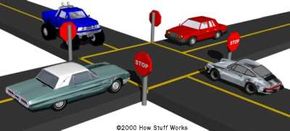The Solution: Adding Switches
Think of a hub as a four-way intersection where everyone has to stop. If more than one car reaches the intersection at the same time, they have to wait for their turn to proceed.
Now imagine what this would be like with a dozen or even a hundred roads intersecting at a single point. The amount of waiting and the potential for a collision increases significantly. But wouldn't it be amazing if you could take an exit ramp from any one of those roads to the road of your choosing? That is exactly what a switch does for network traffic. A switch is like a cloverleaf intersection -- each car can take an exit ramp to get to its destination without having to stop and wait for other traffic to go by.
Advertisement
A vital difference between a hub and a switch is that all the nodes connected to a hub share the bandwidth among themselves, while a device connected to a switch port has the full bandwidth all to itself. For example, if 10 nodes are communicating using a hub on a 10-Mbps network, then each node may only get a portion of the 10 Mbps if other nodes on the hub want to communicate as well. But with a switch, each node could possibly communicate at the full 10 Mbps. Think about our road analogy. If all of the traffic is coming to a common intersection, then each car it has to share that intersection with every other car. But a cloverleaf allows all of the traffic to continue at full speed from one road to the next.
